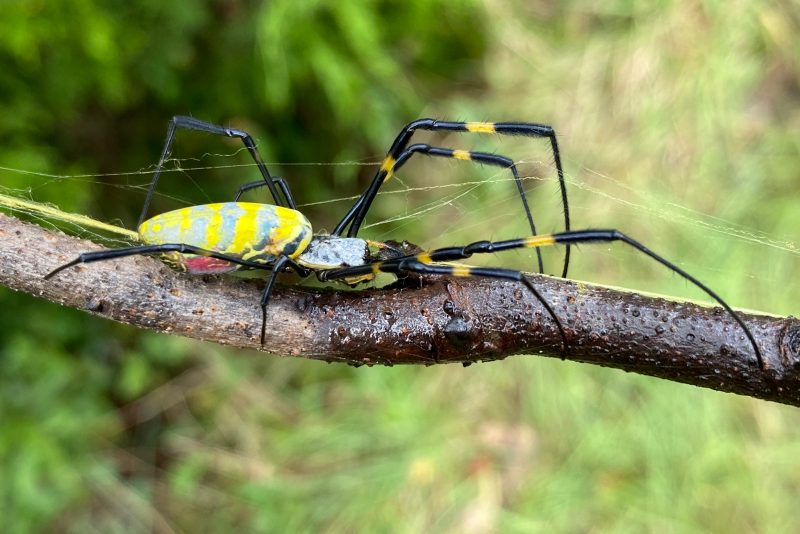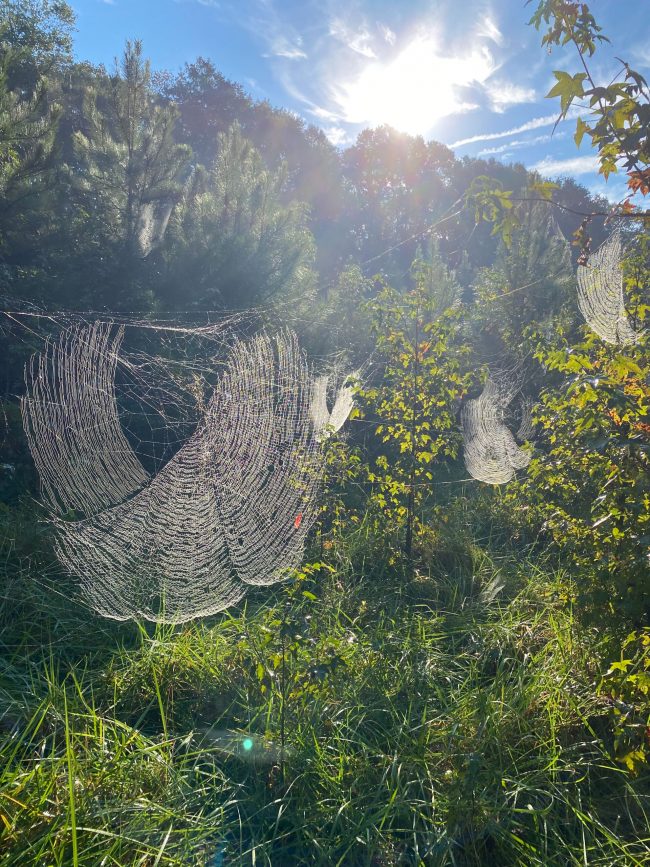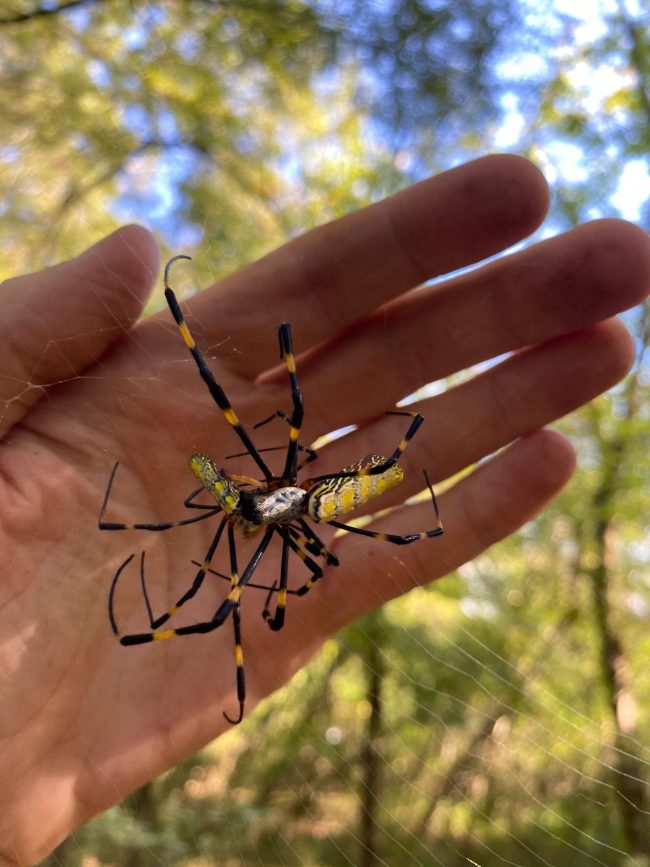Watch a video about the giant, venomous Joro spiders, above.
Giant Joro spiders … coming to your city?
Remember the giant Joro spiders? We first told you about them in 2022, when the University of Georgia reported this giant invasive spider species from Japan would eventually spread up and down the U.S. East Coast. And in 2023, the same scientists said their research revealed Joro spiders are just big scaredy-cats. Now, a new study says these spiders tolerate urban environments well. At the moment, there aren’t sightings of the spider north of Maryland, but experts predict they will eventually reach the big cities of the Northeast.
So how giant are Joro spiders? The female can have a leg span of 3 to 4 inches (about 8 to 10 cm)!
Joro spiders are scaredy-cats
Fortunately, Joro spiders are more scared of us than we are of them (if that’s possible). The 2023 announcement from the University of Georgia said:
The researchers compared more than 450 spiders’ responses to a brief and harmless disturbance across 10 different species. While most spiders froze for less than a minute before resuming their normal activities, the Joro spiders remained motionless for more than an hour.
University of Georgia’s Andy Davis, lead author of the paper, commented:
They basically shut down and wait for the disturbance to go away. Our paper shows that these spiders are really more afraid of you than the reverse.
So, maybe this knowledge can put some 1.2 billion minds at ease. … That’s the number of us who suffer from arachnophobia, or fear of spiders.

Joro spiders new to the U.S.
Back in March 3, 2022, scientists at the University of Georgia announced that a new spider – the Joro spider, which arrived in the southeastern U.S. in 2013 – will eventually spread up and down the East Coast. This venomous spider can grow to the size of an adult’s palm. However, the invasion of this arachnid species might not be all that bad.
The scientists’ new study showed these spiders aren’t outcompeting other spiders as they spread. In fact, they’re not aggressive at all. In the study, the researchers used turkey basters to blow two rapid puffs of air on the spiders. They tested 30 different types of spiders, and most species froze in response to the disturbance for an average of 90 seconds. But Joros stayed frozen for more than an hour.
Co-author Amitesh Anerao of the University of Georgia said:
People were freaking out about the Joro spiders at first, but maybe this paper can help calm people down.
The researchers think the Joro spiders’ shyness may help them conserve energy amid an urban environment rich in stimuli. So how does their timidness reconcile with the idea that they’re taking over the East Coast? Davis said:
One thing this paper tells me is that the Joros’ rapid spread must be because of their incredible reproductive potential. They’re simply outbreeding everybody else. It’s not because they’re displacing native spiders or kicking them out of their own webs.
Why you have no need to fear
Yes, the Joro spider is venomous, but scientists said they’re not a threat to humans (or pets). Despite the spider’s large size, its fangs are quite small. Their defensive bites most likely wouldn’t even break the skin.
And, despite being an invasive species, they may even be beneficial. The spiders eat insects such as stink bugs, which cause crop damage and swarm in homes. They can help control insects without the use of pesticides. Davis said:
People should try to learn to live with them. If they’re literally in your way, I can see taking a web down and moving them to the side, but they’re just going to be back next year.
Or, as Benjamin Frick of the University of Georgia said:
There’s really no reason to go around actively squishing them. Humans are at the root of their invasion. Don’t blame the Joro spider.

How Joro spiders arrived, and how they’ll spread
Joro spiders are originally from Japan, but they also live in China and Korea. They most likely hitched a ride to the United States on shipping containers. Researchers believe they first appeared in the U.S. about 80 miles (130 km) north of Atlanta. They’ve since spread to many counties in northern Georgia, parts of Tennessee and the Carolinas.
While these spiders can catch a ride on things like shipping containers, cars and luggage, they can also transport themselves on their webs. They fly through the air on a strand of silk in a technique scientists call ballooning. They parachute into new areas to expand their range. It’s how newly hatched Joro spiders spread.
The researchers have accidentally found out just how easy it is for Joro spiders to catch a ride to new locales. Frick said:
The potential for these spiders to be spread through people’s movements is very high. Anecdotally, right before we published this study, we got a report from a grad student at UGA who had accidentally transported one of these to Oklahoma.

The cold won’t stop them
These colorful spiders appear to be hardy enough to survive cold temperatures, which will help them spread. As Davis said:
It looks like the Joros could probably survive throughout most of the Eastern Seaboard here, which is pretty sobering.
A similar spider, the golden silk spider, arrived in the United States from the tropics more than 150 years ago. But this species wasn’t able to spread outside of the southeastern U.S. Joros, unlike the golden silk spider, have a high metabolism, high heart rate and an ability to withstand cold.
The iNaturalist website and app enables people to record their observations of what they see in the natural world around them. (It led to the discovery of an unnamed grasshopper in 2021.) The scientists looked at Joro reports from iNaturalist and their locations. They also measured the spiders’ heart, metabolic and survival rates during a brief freeze.
They found that the Joro spider has double the metabolism of the golden silk spider. It also has a 77% higher heart rate. Basically, the Joro spider is better equipped physically to survive in colder temperatures. And as Anerao said:
They’re so good at living with humans that they’re probably not going away anytime soon.

Bottom line: The giant Joro spiders are not going anywhere … except maybe to a city near you. The spiders continue to track up the East Coast.
Source: Startle Responses of Joro Spiders (Trichonephila clavata) to Artificial Disturbance











